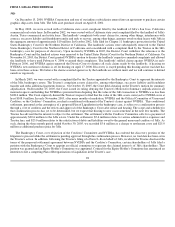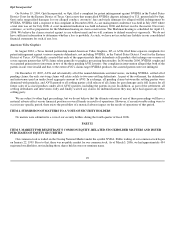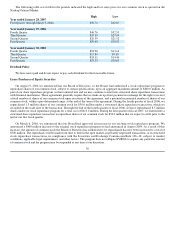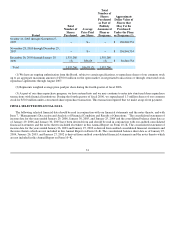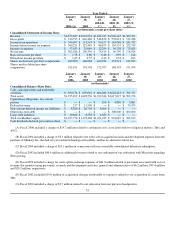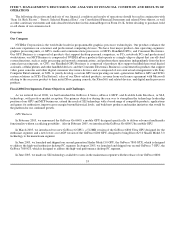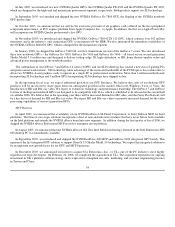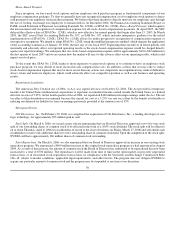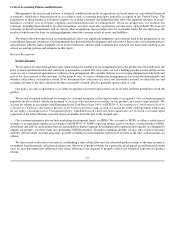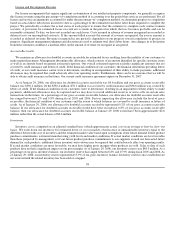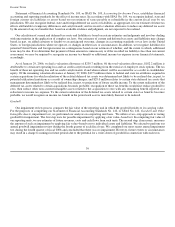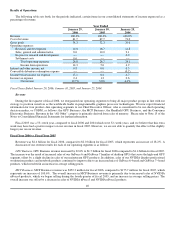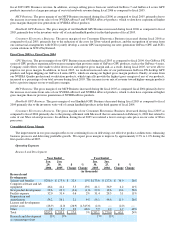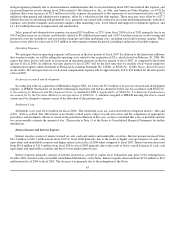NVIDIA 2006 Annual Report Download - page 43
Download and view the complete annual report
Please find page 43 of the 2006 NVIDIA annual report below. You can navigate through the pages in the report by either clicking on the pages listed below, or by using the keyword search tool below to find specific information within the annual report.
Critical Accounting Policies and Estimates
Management's discussion and analysis of financial condition and results of operations are based upon our consolidated financial
statements, which have been prepared in accordance with accounting principles generally accepted in the United States. The
preparation of these financial statements requires us to make estimates and judgments that affect the reported amounts of assets,
liabilities, revenue, cost of revenue, expenses and related disclosure of contingencies. On an on−going basis, we evaluate our
estimates, including those related to revenue recognition, accounts receivable, inventories, income taxes, and goodwill. We base our
estimates on historical experience and on various other assumptions that are believed to be reasonable under the circumstances, the
results of which form the basis for making judgments about the carrying values of assets and liabilities.
We believe the following critical accounting policies affect our significant judgments and estimates used in the preparation of our
consolidated financial statements. Our management has discussed the development and selection of these critical accounting policies
and estimates with the audit committee of our board of directors and the audit committee has reviewed our disclosures relating to our
critical accounting policies and estimates in this report.
Revenue Recognition
Product Revenue
We recognize revenue from product sales when persuasive evidence of an arrangement exists, the product has been delivered, the
price is fixed and determinable and collection is reasonably assured. For most sales, we use a binding purchase order and in certain
cases we use a contractual agreement as evidence of an arrangement. We consider delivery to occur upon shipment provided title and
risk of loss have passed to the customer. At the point of sale, we assess whether the arrangement fee is fixed and determinable and
whether collection is reasonably assured. If we determine that collection of a fee is not reasonably assured, we defer the fee and
recognize revenue at the time collection becomes reasonably assured, which is generally upon receipt of cash.
Our policy on sales to distributors is to defer recognition of revenue and related cost of revenue until the distributors resell the
product.
We record estimated reductions to revenue for customer programs at the time revenue is recognized. Our customer programs
primarily involve rebates, which are designed to serve as sales incentives to resellers of our products in various target markets. We
account for rebates in accordance with Emerging Issues Task Force Issue 01−9, or EITF 01−9, Accounting for Consideration Given by
a Vendor to a Customer (Including a Reseller of the Vendor's Products) and, as such, we accrue for 100% of the potential rebates and
do not apply a breakage factor. Unclaimed rebates, which historically have not been significant, are reversed to revenue upon
expiration of the rebate. Rebates typically expire six months from the date of the original sale.
Our customer programs also include marketing development funds, or MDFs. We account for MDFs as either a reduction of
revenue or an operating expense in accordance with EITF 01−9. MDFs represent monies paid to retailers, system builders, OEMs,
distributors and add−in card partners that are earmarked for market segment development and expansion and typically are designed to
support our partners' activities while also promoting NVIDIA products. If market conditions decline, we may take actions to increase
amounts offered under customer programs, possibly resulting in an incremental reduction of revenue at the time such programs are
offered.
We also record a reduction to revenue by establishing a sales return allowance for estimated product returns at the time revenue is
recognized, based primarily on historical return rates. However, if product returns for a particular fiscal period exceed historical return
rates we may determine that additional sales return allowances are required to properly reflect our estimated exposure for product
returns.
37



